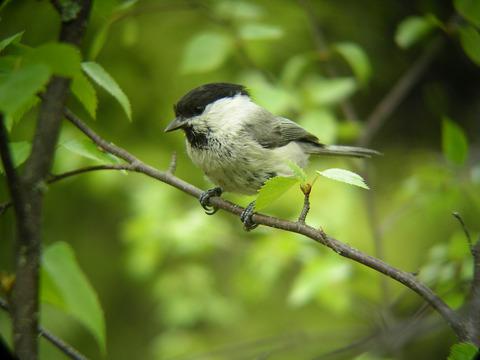当前位置:
X-MOL 学术
›
J. Anim. Ecol.
›
论文详情
Our official English website, www.x-mol.net, welcomes your feedback! (Note: you will need to create a separate account there.)
Effects of ambient temperatures on evolutionary potential of reproductive timing in boreal passerines
Journal of Animal Ecology ( IF 4.8 ) Pub Date : 2020-10-26 , DOI: 10.1111/1365-2656.13370 Emma Vatka 1 , Markku Orell 2 , Seppo Rytkönen 2 , Juha Merilä 1, 3
Journal of Animal Ecology ( IF 4.8 ) Pub Date : 2020-10-26 , DOI: 10.1111/1365-2656.13370 Emma Vatka 1 , Markku Orell 2 , Seppo Rytkönen 2 , Juha Merilä 1, 3
Affiliation

|
Many populations need to adapt to changing environmental conditions, such as warming climate. Changing conditions generate directional selection for traits critical for fitness. For evolutionary responses to occur, these traits need to be heritable. However, changes in environmental conditions can alter the amount of heritable variation a population expresses, making predictions about expected responses difficult. The aim of this study was to evaluate the effects of ambient temperatures on evolutionary potential and strength of natural selection on the timing of reproduction in two passerine birds breeding in boreal forests. Long-term data on individually marked Willow Tits (Poecile montanus, 1975-2018) and Great Tits (Parus major, 1969-2018) were analysed with random regression animal models to assess if spring temperatures affect the expressed amount of additive genetic variation (VA) and heritability (h2) in the timing of breeding. We assessed if ambient temperatures of different seasons influenced the direction and strength of selection on breeding time. We also evaluated if the strength of selection co-varied with evolutionary potential. Levels of VA or h2 expressed in laying date were unaffected by spring temperatures in both study species. Selection for earlier breeding was found in the Willow Tit, but not in the Great Tit. In the Willow Tit, selection for earlier breeding was more intense when the temperatures of following autumns and winters were low. Different measures of evolutionary potential did not co-vary strongly with the strength of selection in either species. We conclude that there is no or little evidence that climate warming would either constrain or promote evolutionary potential in timing of breeding through changes in amount of genetic variance expressed in boreal Willow and Great Tits. However, selection on the timing of breeding, a life-history event taking place in springtime, is regulated by temperatures of autumns and winters. Rapid warming of these periods have thus potential to reduce the rate of expected evolutionary response in reproductive timing.
中文翻译:

环境温度对北方雀类繁殖时间进化潜力的影响
许多人口需要适应不断变化的环境条件,例如气候变暖。不断变化的条件会产生对适合度至关重要的性状的定向选择。为了发生进化反应,这些特征需要是可遗传的。然而,环境条件的变化会改变种群表达的可遗传变异量,使得对预期反应的预测变得困难。本研究的目的是评估环境温度对进化潜力的影响,以及自然选择强度对在北方森林中繁殖的两只雀鸟繁殖时间的影响。单独标记的 Willow Tits (Poecile montanus, 1975-2018) 和 Great Tits (Parus major, 1969-2018) 使用随机回归动物模型进行分析,以评估春季温度是否影响繁殖时间的加性遗传变异 (VA) 和遗传力 (h2) 的表达量。我们评估了不同季节的环境温度是否会影响繁殖时间的选择方向和强度。我们还评估了选择的强度是否与进化潜力共同变化。在两个研究物种中,产蛋日期表示的 VA 或 h2 水平不受春季温度的影响。在 Willow Tit 中发现了早期繁殖的选择,但在 Great Tit 中没有。在随后的秋冬季气温较低的情况下,柳山雀的早育选择更加激烈。进化潜力的不同测量与任一物种的选择强度没有强烈的共同变化。我们得出的结论是,没有或几乎没有证据表明气候变暖会通过北柳和大山雀中表达的遗传变异量的变化来限制或促进繁殖时间的进化潜力。然而,繁殖时间的选择是发生在春季的生活史事件,受秋季和冬季的温度调节。因此,这些时期的快速变暖有可能降低生殖时间中预期进化反应的速度。我们得出的结论是,没有或几乎没有证据表明气候变暖会通过北柳和大山雀中表达的遗传变异量的变化来限制或促进繁殖时间的进化潜力。然而,繁殖时间的选择是发生在春季的生活史事件,受秋季和冬季的温度调节。因此,这些时期的快速变暖有可能降低生殖时间中预期进化反应的速度。我们得出的结论是,没有或几乎没有证据表明气候变暖会通过北柳和大山雀中表达的遗传变异量的变化来限制或促进繁殖时间的进化潜力。然而,繁殖时间的选择是发生在春季的生活史事件,受秋季和冬季的温度调节。因此,这些时期的快速变暖有可能降低生殖时间中预期进化反应的速度。
更新日期:2020-10-26
中文翻译:

环境温度对北方雀类繁殖时间进化潜力的影响
许多人口需要适应不断变化的环境条件,例如气候变暖。不断变化的条件会产生对适合度至关重要的性状的定向选择。为了发生进化反应,这些特征需要是可遗传的。然而,环境条件的变化会改变种群表达的可遗传变异量,使得对预期反应的预测变得困难。本研究的目的是评估环境温度对进化潜力的影响,以及自然选择强度对在北方森林中繁殖的两只雀鸟繁殖时间的影响。单独标记的 Willow Tits (Poecile montanus, 1975-2018) 和 Great Tits (Parus major, 1969-2018) 使用随机回归动物模型进行分析,以评估春季温度是否影响繁殖时间的加性遗传变异 (VA) 和遗传力 (h2) 的表达量。我们评估了不同季节的环境温度是否会影响繁殖时间的选择方向和强度。我们还评估了选择的强度是否与进化潜力共同变化。在两个研究物种中,产蛋日期表示的 VA 或 h2 水平不受春季温度的影响。在 Willow Tit 中发现了早期繁殖的选择,但在 Great Tit 中没有。在随后的秋冬季气温较低的情况下,柳山雀的早育选择更加激烈。进化潜力的不同测量与任一物种的选择强度没有强烈的共同变化。我们得出的结论是,没有或几乎没有证据表明气候变暖会通过北柳和大山雀中表达的遗传变异量的变化来限制或促进繁殖时间的进化潜力。然而,繁殖时间的选择是发生在春季的生活史事件,受秋季和冬季的温度调节。因此,这些时期的快速变暖有可能降低生殖时间中预期进化反应的速度。我们得出的结论是,没有或几乎没有证据表明气候变暖会通过北柳和大山雀中表达的遗传变异量的变化来限制或促进繁殖时间的进化潜力。然而,繁殖时间的选择是发生在春季的生活史事件,受秋季和冬季的温度调节。因此,这些时期的快速变暖有可能降低生殖时间中预期进化反应的速度。我们得出的结论是,没有或几乎没有证据表明气候变暖会通过北柳和大山雀中表达的遗传变异量的变化来限制或促进繁殖时间的进化潜力。然而,繁殖时间的选择是发生在春季的生活史事件,受秋季和冬季的温度调节。因此,这些时期的快速变暖有可能降低生殖时间中预期进化反应的速度。



























 京公网安备 11010802027423号
京公网安备 11010802027423号